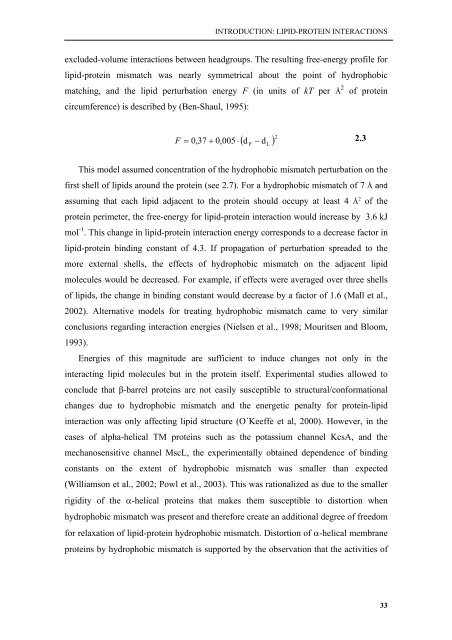Biophysical studies of membrane proteins/peptides. Interaction with ...
Biophysical studies of membrane proteins/peptides. Interaction with ...
Biophysical studies of membrane proteins/peptides. Interaction with ...
Create successful ePaper yourself
Turn your PDF publications into a flip-book with our unique Google optimized e-Paper software.
INTRODUCTION: LIPID-PROTEIN INTERACTIONS<br />
excluded-volume interactions between headgroups. The resulting free-energy pr<strong>of</strong>ile for<br />
lipid-protein mismatch was nearly symmetrical about the point <strong>of</strong> hydrophobic<br />
matching, and the lipid perturbation energy F (in units <strong>of</strong> kT per Å 2 <strong>of</strong> protein<br />
circumference) is described by (Ben-Shaul, 1995):<br />
F<br />
( ) 2<br />
= 0,37<br />
+ 0,005 ⋅ d P<br />
− d L<br />
2.3<br />
This model assumed concentration <strong>of</strong> the hydrophobic mismatch perturbation on the<br />
first shell <strong>of</strong> lipids around the protein (see 2.7). For a hydrophobic mismatch <strong>of</strong> 7 Å and<br />
assuming that each lipid adjacent to the protein should occupy at least 4 Å 2 <strong>of</strong> the<br />
protein perimeter, the free-energy for lipid-protein interaction would increase by 3.6 kJ<br />
mol -1 . This change in lipid-protein interaction energy corresponds to a decrease factor in<br />
lipid-protein binding constant <strong>of</strong> 4.3. If propagation <strong>of</strong> perturbation spreaded to the<br />
more external shells, the effects <strong>of</strong> hydrophobic mismatch on the adjacent lipid<br />
molecules would be decreased. For example, if effects were averaged over three shells<br />
<strong>of</strong> lipids, the change in binding constant would decrease by a factor <strong>of</strong> 1.6 (Mall et al.,<br />
2002). Alternative models for treating hydrophobic mismatch came to very similar<br />
conclusions regarding interaction energies (Nielsen et al., 1998; Mouritsen and Bloom,<br />
1993).<br />
Energies <strong>of</strong> this magnitude are sufficient to induce changes not only in the<br />
interacting lipid molecules but in the protein itself. Experimental <strong>studies</strong> allowed to<br />
conclude that β-barrel <strong>proteins</strong> are not easily susceptible to structural/conformational<br />
changes due to hydrophobic mismatch and the energetic penalty for protein-lipid<br />
interaction was only affecting lipid structure (O´Keeffe et al, 2000). However, in the<br />
cases <strong>of</strong> alpha-helical TM <strong>proteins</strong> such as the potassium channel KcsA, and the<br />
mechanosensitive channel MscL, the experimentally obtained dependence <strong>of</strong> binding<br />
constants on the extent <strong>of</strong> hydrophobic mismatch was smaller than expected<br />
(Williamson et al., 2002; Powl et al., 2003). This was rationalized as due to the smaller<br />
rigidity <strong>of</strong> the α-helical <strong>proteins</strong> that makes them susceptible to distortion when<br />
hydrophobic mismatch was present and therefore create an additional degree <strong>of</strong> freedom<br />
for relaxation <strong>of</strong> lipid-protein hydrophobic mismatch. Distortion <strong>of</strong> α-helical <strong>membrane</strong><br />
<strong>proteins</strong> by hydrophobic mismatch is supported by the observation that the activities <strong>of</strong><br />
33















